When visiting Namibia you are likely to pass through the capital, Windhoek, before travelling onwards to explore the country. We show you how to walk round the best of the city of Windhoek in less than one day to see what it has to offer.
The Capital City
Windhoek or ‘windy corner’ in Afrikaans has a population of around 322,000 and sits at an altitude of 1650 metres. Although this helps take the edge off the heat, by Namibian standards, temperatures in high summer still regularly hit 35celcius / 94 farenheight. If you can afford to be flexible, start the walk in early morning before the heat builds up.
One Day in Windhoek on Foot
It is a relatively small compact capital and, based on our experience, if you only have one day in Windhoek, here are the top sights to see during a self guided walking tour around the centre.
Depending on the time available you can see most of it in 3-4 hours or so. If you have the enregy, time and inclination we have also suggested extras you can add on. This should still allow for some refreshments or shopping along the way.
Independence Avenue
Start on Independence Avenue, the city’s main shopping street. It is here you’ll find a selection of shops and cafes. This is very much the heart of Windhoek and the street cuts straight through the centre of the city. As a result you’ll find it is a useful reference point as you walk around.
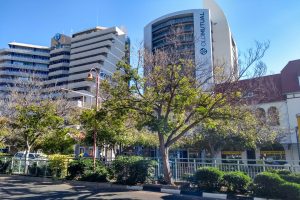
Zoo Park
On Independence Avenue between Fidel Castro Street and Park Street, the Zoo Park is a grassed area with plenty of shade from its many trees. It takes its name from the small zoo that was once stood here in German colonial times. From the Park you get a good view of some of the colonial buildings on the east side.
Post Street Mall
The Post Street Mall, on the east side of Independence Avenue, is a good place to shop for souvenirs (look out for the old clock tower). It is a mix of chain stores, curio shops, craft stores and cafes. Areas of the mall have also been set aside for craft sellers and wood carvers.

The Gibeon Meteorite National Monument
In the Post Street Mall area, is a fountain/monument that includes 33 fragments of what is claimed to be the largest ever meteor shower to hit the earth, close to the town of Gibeon, around 500 million years ago. Although first documented in 1838 they were only collected in the early 20th century.
The Christus Kirke
From the corner of Fidel Castro Street and Independence Avenue (by the Zoo Park) you’ll see the Christus Kirke when walking up the hill. It is one of the most iconic and most photographed buildings in Windhoek. The Church is located on a traffic island on Robert Mugabe Avenue, opposite the Parliament Buildings. It dates from 1910, following the wars between the Germans and the Khoikhoi, Herero and Owambo tribes.
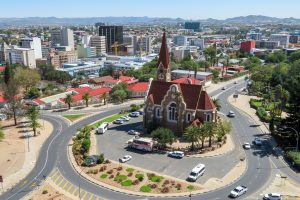
Parliament Buildings & Gardens
As you climb Fidel Castro Street and face the church, the Parliament buildings and gardens are a little to your left (north) on Robert Mugabe Avenue. The gardens in front of the Parliament Building are well kept and worth a look. They once housed the Colonial Government’s adminstrative headquarters which were nicknamed the Tintenplast or ‘Ink Palace’ a reference to the amount of ink the bureacrats used to get through.
Related Reading: Exploring the Best of Namibia in Pictures
Immediately in front of the Parliament building you will find the liberation statues. These depict heroes of the Namibian liberation struggles, Hendrick Witbooi, Hosea Kutako (who the airport is named after), and Theophilus Hingashi-kuka Hamutumbangela.
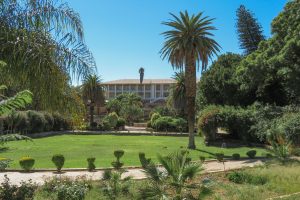
Independence Memorial Museum
Slightly south on Robert Mugabe Avenue stands the Independence Memorial Museum. Designed by North Korean architects, it is a tall gold coloured building with external elevators. It houses exhibitions covering Namibian colonial times and its struggles for independence. There is a cafe at the top which offers beautiful, unrestricted views of the city. Although, to take pictures the staff expect that you will buy something to eat or drink.
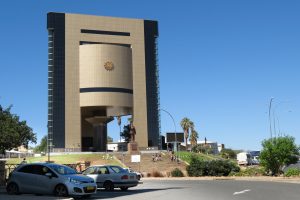
The Alte Feste
Continuing south on Robert Mugabe Avenue and next to the Independence Memorial Museum is the Alte Feste. This is Windhoek’s oldest building, built in the late 19th century as German headquarters. It now contains the history section of the National Museum of Namibia.
Related Reading: The Best Way to do a Namibia Road Trip
Inside the courtyard of the Alte Feste is an equestrian monument, known as the Reiterdenkmal statue. It dates from 1912 and honours the soldiers and civilians that died on the German side of the Herero and Namaqua War of 1904–1907. The bronze statue was moved from its prominent position where the Independence Memorial Museum now stands. You can catch a glimpse of it from the cafe at the top of the Independence Museum.

Kaiserliche Realschule
On the other side of Robert Mugabe Avenue you will see the Kaiserliche Realschule. Dating from 1907 it was the first German Primary School in Windhoek. It has since been a German secondary school, an English school and now Government offices.
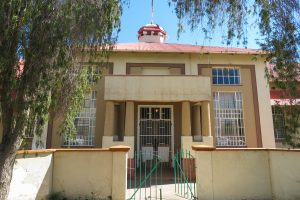
The Officers House
If you walk a little further south, at the corner of Robert Mugabe Avenue and Sam Nujoma Drive sits the Officers House. It is now used by the Bank of Namibia as their training centre. Built in 1906/07 it originally housed senior officials. It is a good example of colonial architecture.

Tienmannhaus (Ten Man House)
Carry on south on Robert Mugabe Avenue for another block. If you turn right into Kalk Street, then left into Rev. Micheal Scott Street you’ll find Tienmannhaus (Ten Man House), an H shaped fortress style building dating from 1906 and built to provide accommodation for 10 unmarried government officials. Its a particularly good example of the German colonial style architecture. This is as far south in the city as you need to go.

The Namibian Craft Centre
From Ten Man House head back north along Rev. Michael Scott Street, cross Kalk Street and turn left into Garten Street. Continue across Independence Avenue until you reach Tal Street when on turning right you’ll arrive at the Craft Centre. Set in a refurbished brewery where Windhoek Lager was once produced, the craft centre is packed with 40 outlets all under one roof. Unsurprisingly it is a pleasant place to browse for local crafts and souvenirs. The cafe on the first floor is popular and has a shaded balcony. It makes a good stop for refreshments or lunch at a reasonable price. You can pick up anything from a fridge magnet to a 2 metre high wood carving if you fancy paying to get it home.

Want to See More?
During your one day in Windhoek, if after exploring the craft market and having used the cafe you are keen to see some more, then when leaving the craft market head back to Fidel Castro Street. To do this turn right into Tal Street and right again into Sam Nujoma Drive. When you reach Independence Avenue turn left then take a right into Fidel Castro Street. Once again approach the Christus Kirke. This time instead of going right, turn left and walk north along Robert Mugabe Avenue.
Other Colonial Buildings
Over the next couple of blocks you’ll pass a number of other colonial buildings, mostly now used as Government offices including Estorff House, Hauptkasse and Dernberg House.
The Owela Museum
Within a few minutes you will pass the Owela Museum on the left hand side which houses the natural history section of the National Museum of Namibia.
The National Art Gallery
Staying on Robert Mugabe Avenue, at the corner of John Meinert Street and next to the National Theatre is the National Art Gallery of Namibia. If you are interested in Art then the building holds both permanent and temporary displays on a broad range of styles and periods. When leaving the Art Gallery head west (left) down John Meinert Street and turn right (north) into Independence Avenue.
The Old Railway Station
From Independence Avenue turn left after a block and head along Banhoff Street. Windhoek’s old railway station will be on your right after around 200 yards. Built by the Germans in 1912 is well worth a look, particularly if you are a bit of a train buff. There is also a little museum on the upper floor covering the history of train travel in Namibia.

There are now only a few trains leave the station but these do include the Trans Namib Desert Express which runs between Windhoek and Swakopmund and also luxury train safaris. If you are lucky enough to find one of these luxury trains in the station when you visit don’t miss the opportunity to have a good look at it. We found station staff accommodating and willing to let you through onto the platform.
The Kudu Statue
From the Station retrace your steps back along Banhoff Street to Independence Avenue and turn right to head back to the centre. As you go keep and eye out on your left hand side for the bronze statue of a Kudu. This was a donation from a wealthy businessman in memory of an epidemic which wiped up thousands of Kudu and cattle in the late 19th century.

Related Reading: Capturing big cats at AfriCat Foundation, Okonjima
Looking for More?
If you liked this post on One Day in Windhoek and are looking for some further reading then below you’ll find more of our articles on Namibia. For related reading check out the Tag links as well at the bottom of the page.
More Reading on Namibia
Before You Go
Before you leave this post, it would be good if you could take a few moments to subscribe for website updates and follow us on social media. You can also share this post on your favourite social media channels which we would welcome. You can find all the links in the section below. Finally, if you have any thoughts or questions please leave them in the comments section at the bottom of the page. We will get back to you.
Follow us on Social Media
Join our Mailing List
Make sure you don’t miss out by entering your email address below

By clicking submit, you agree to share your email address with the site owner and Mailchimp to receive marketing, updates, and other emails from the site owner. Use the unsubscribe link in those emails to opt out at any time.








